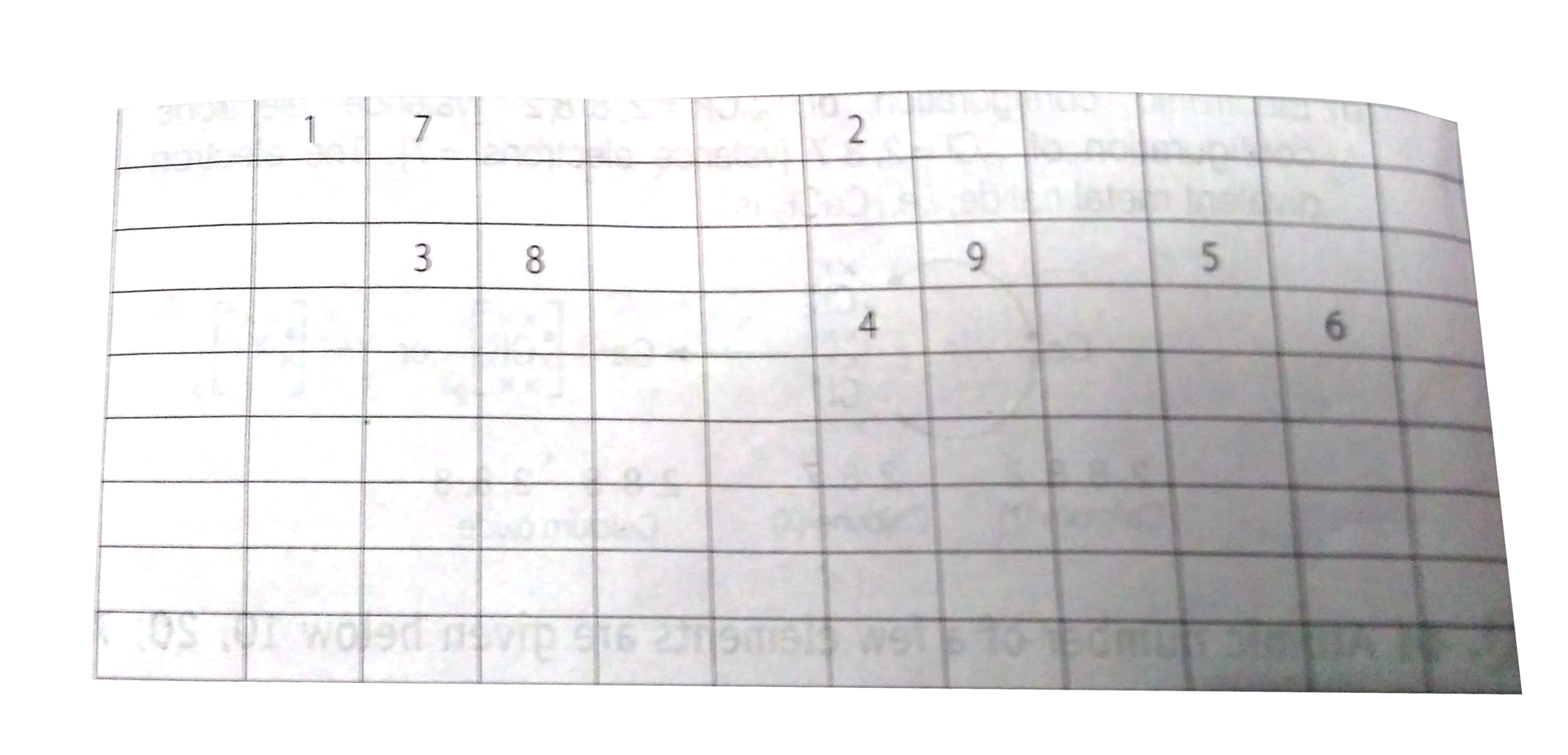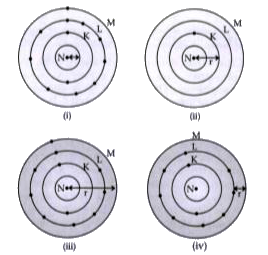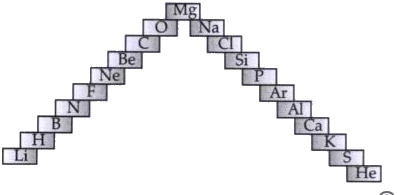NCERT EXEMPLAR (LONG ANSWER QUESTIONS) from OSWAL PUBLICATION PERIODIC CLASSIFICATION OF ELEMENTS for Class 10
| Class 10 | CHEMISTRY |
| Chapter | PERIODIC CLASSIFICATION OF ELEMENTS |
| OSWAL PUBLICATION | NCERT EXEMPLAR (LONG ANSWER QUESTIONS) |
| Medium | English |
| Academic Year | 2023-2024 |
Question 4
Which of the following statements (s) about the modern periodic table are incorrect ?
(i) The elements in the modern periodic table are arranged on the basis of their decreasing atomic numbers
(ii) The elements in the modern periodic table are arranged on the basiss of their increasing atomic mases.
(iii) Isotopes are placed in adjoining group(s) in the periodic table
(iv) The elements in the modern periodic table are arranged on the basis of their increasing atomic number.View SolutionQuestion 16
Which of the following are the characteristics of isotopes of an element?
(i) Isotopes of an element have same atomic masses.
(ii) Isotopes of an element have same atomic number.
(iii) Isotopes of an element show same physical properties.
(iv) Isotopes of an element show same chemical properties. View SolutionQuestion 68
Complete the following crossword puzzle (Figure)
Across
(1) An element with atomic number 12
(3) Metal used in making cans and member of group 14
(4) A lustrous non-metal which has 7 electrons in its outermost shell
Down
(2) Highly reactive and soft metal which imparts yellow colour when subjected to flame and is kept in kerosene
(5) The first element of second period
(6) An element whihc is used in making flurescent bulbs and is second member of group 18 in the modern periodic table
(7) A radioactive element which is the last member of halogen family
(8) Metal which is an important constituent of steel and forms rust when exposed to moist air
(9) The first metalloid in modern periodic table whose fibres are used in making bullet-proof vests
 View Solution
View SolutionQuestion 75
(a) Electropositive nature of the element(s) increases down the group and decreases across the period.
(b) Electronegativity of the element decreases down the group and increases across the period.
(c) Atomic size increases down the group and decreases across a period (left to right).
(d) Metallic character increases down the group and decreases across a period.
On the basis of the above trends of the Periodic Table, answer the following about the elements with atomic numbers 3 to 9.
Name the most electropositive element among them. View SolutionQuestion 76
(a) Electropositive nature of the element(s) increases down the group and decreases across the period.
(b) Electronegativity of the element decreases down the group and increases across the period.
(c) Atomic size increases down the group and decreases across a period (left to right).
(d) Metallic character increases down the group and decreases across a period.
On the basis of the above trends of the Periodic Table, answer the following about the elements with atomic numbers 3 to 9.
Name the most electronegative element.View SolutionQuestion 77
(a) Electropositive nature of the element(s) increases down the group and decreases across the period.
(b) Electronegativity of the element decreases down the group and increases across the period.
(c) Atomic size increases down the group and decreases across a period (left to right).
(d) Metallic character increases down the group and decreases across a period.
On the basis of the above trends of the Periodic Table, answer the following about the elements with atomic numbers 3 to 9.
Name the element with smallest atomic size.View SolutionQuestion 78
(a) Electropositive nature of the element(s) increases down the group and decreases across the period.
(b) Electronegativity of the element decreases down the group and increases across the period.
(c) Atomic size increases down the group and decreases across a period (left to right).
(d) Metallic character increases down the group and decreases across a period.
On the basis of the above trends of the Periodic Table, answer the following about the elements with atomic numbers 3 to 9.
Name the element which is a metalloid.View SolutionQuestion 79
(a) Electropositive nature of the element(s) increases down the group and decreases across the period.
(b) Electronegativity of the element decreases down the group and increases across the period.
(c) Atomic size increases down the group and decreases across a period (left to right).
(d) Metallic character increases down the group and decreases across a period.
On the basis of the above trends of the Periodic Table, answer the following about the elements with atomic numbers 3 to 9.
Name the element which shows maximum valency. View SolutionQuestion 82
An element X which is a yellow solid at room temperature shows catenation and allotropy. X forms two oxides which are also formed during the thermal decomposition of ferrous sulphate crystals and are the major air pollutants.
Write the balanced chemical equation for the thermal decomposition of ferrous sulphate crystals? View SolutionQuestion 83
An element X which is a yellow solid at room temperature shows catenation and allotropy. X forms two oxides which are also formed during the thermal decomposition of ferrous sulphate crystals and are the major air pollutants.
What would be the nature (acidic/ basic) of oxides formed? View SolutionQuestion 84
An element X which is a yellow solid at room temperature shows catenation and allotropy. X forms two oxides which are also formed during the thermal decomposition of ferrous sulphate crystals and are the major air pollutants.
Locate the position of the element in the Modern Periodic Table View SolutionQuestion 86
An element X of group 15 exists as diatomic molecule and combines with hydrogen at 773 K in presence of the catalyst to form a compound, ammonia which has a characteristic pungent smell.
Draw the electron dot structure of the diatomic molecule of X. What type of bond is formed in it? View Solution
All Exercises from OSWAL PUBLICATION Class 10 CHEMISTRY PERIODIC CLASSIFICATION OF ELEMENTS
- MULTIPLE CHOICE QUESTIONS
- SELF - ASSESSMENT - 1 ( OBJECTIVE TYPE QUESTIONS)
- STAND ALONE MCQS
- ASSERTION AND REASON BASED MCQS
- CASE BASED QUESTIONS
- SELF - ASSESSMENT - 2 ( OBJECTIVE TYPE QUESTIONS)
- CASE - BASED MCQS
- NCERT CORNER (EXERCISE QUESTIONS)
- NCERT CORNER (INTEXT CORNER)
- REASONING BASED QUESTIONS
- NCERT EXEMPLAR (LONG ANSWER QUESTIONS)
- NCERT EXEMPLAR (MULTIPLE CHOICE QUESTIONS)
- NCERT EXEMPLAR (SHORT ANSWER QUESTIONS)
- VERY SHORT ANSWER TYPE QUESTIONS
- BOARD CORNER (LONG ANSWER TYPE QUESTIONS)
- BOARD CORNER (SHORT ANSWER TYPE QUESTIONS)
- SHORT ANSWER TYPE QUESTIONS
- LONG ANSWER TYPE QUESTIONS
- DIFFERENTIATE BETWEEN
- ANALYSIS AND EVALUATION BASED QUESTIONS
- CREATING BASED QUESTIONS
- SELF - ASSESSMENT


